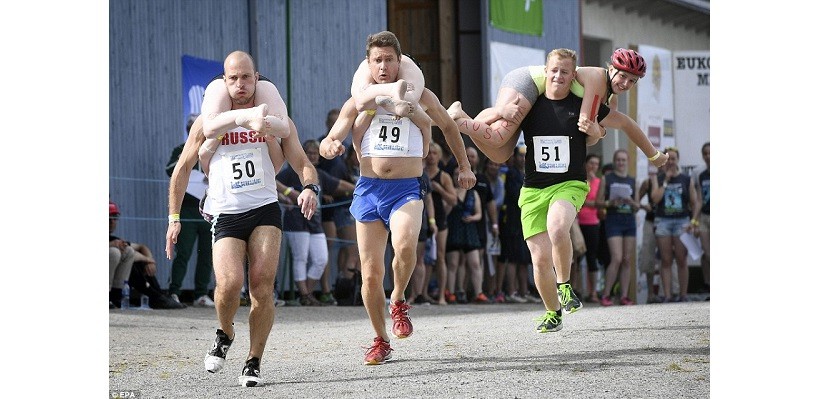Wife-carrying contest: Finland

Welcome to English Waves! I’m Sarah Heath with traditions around the globe.
Every July, a small village called Sonkajärvi, which is located almost smack in the middle of Finland, welcomes couples from all over the globe for what must be one of the strangest sporting events in the world. The name for the sport in Finnish is Eukonkanto; in English, it is better known – and easier to say – as a wife-carrying race!
About 500km north of Helsinki, Sonkajärvi is a municipality in the Northern Savonia region and has a population of around 4,000 people. Best known for its stunning lakes, once a year people flock to the area to take part in a race which is a test of strength, endurance and above all, a good sense of humour!
The race became an official event in 1994 but the history behind it goes back to the end of the nineteenth century. The story goes that a bunch of outlaw led by gangster Rosvo-Ronkainen, would only allow new recruits into their gang by successfully completing a feat of strength by carrying heavy sacks slung on their backs over a certain distance. It has also been suggested that these men would sneak into villages to find themselves a wife and kidnap women by literally throwing them over their shoulder and running away! These Viking-types clearly needed some lessons in seduction back in those days!
Back to the present day, in 2018, 53 men wrapped their wives or partners around them like scarves before setting off down the 253.5 metre track. In this year’s race, that number has increased to 80 competing couples. The over-riding rule seems to be that all competitors must enjoy themselves but there are some more practical stipulations. Couples must constitute one male and one female; the woman must weigh at least 49kgs or must wear a weighted rucksack on her back to reach that minimum weight; and the woman must be at least 17 years old.
No equipment is allowed save a helmut for the woman being carried and a belt which can be worn by the man for the wife to have something to hold onto! The winner is the couple who complete the course in the quickest time.
The wife-carrying method is open and flexible: some opt for the piggyback approach; others do a traditional fireman’s lift by carrying the woman over one shoulder; some carry her sideways over both shoulders but the most popular practice seems to involve dangling the woman upside-down on the carrier’s back, as she wraps her legs around her husband’s neck. Known as the Estonian style, it’s somewhat intimate and it becomes obvious why it is more-often-than-not a husband and wife team! Being married also makes training easier as couples can practice at home: walking the dog or even going to the gym together with the wife stuck like a limpet to her husband’s back.
The race itself involves completing the obstacle course while running through sand and a forest as well as running along a road section. There are also two logs to negotiate where the man has to be careful not to bash his upside-down wife’s head on the log as he climbs over! And there is a shallow pool which throws up its own safety hazards: the men leap into the pool and if the wife is being carried upside-down, she needs to be able to lift her head out of the water so as not to start choking on it!
The speed with which the teams get round the course is impressive – last year’s winners, a Lithuanian couple, made it round in 1 minute five seconds, clinching a victory on their fourth attempt in the race. The champion of champions is former Finnish athlete, Taisto Miettinen who has won the race six times, these triumphs among a total of thirteen victories in wife-carrying competitions. The sport and the undoubted fitness and skill necessary to complete the course has not gone unnoticed by official bodies: wife carrying has now become a category in the Guinness Book of World Records.
Possibly most importantly of all, is the prize! The winners walk away with a quantity of beer equivalent to the wife’s body weight!
Listen in to English Waves for the next program on world traditions.








COMMENTS